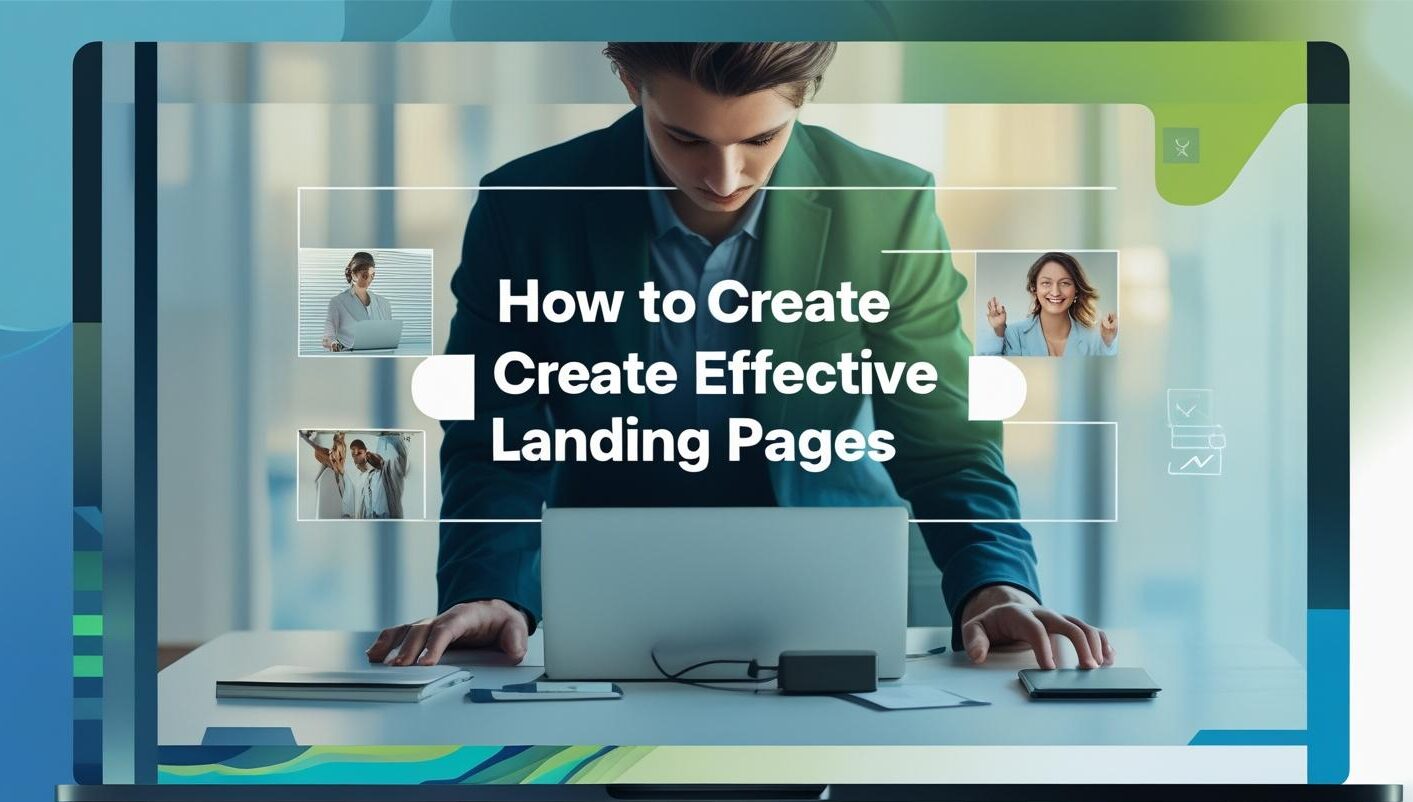How to Create Effective Landing Pages
Turn Visitors into Conversions with Smart Page Design
Introduction:
In digital marketing, a landing page is where first impressions are formed—and often where sales are won or lost. Whether you’re running a Google Ads campaign, promoting a product on social media, or driving organic traffic through SEO, your landing page should convert that traffic into leads, subscribers, or paying customers.
Landing pages are essential to digital marketing. They’re designed to convert visitors into customers by encouraging a specific action. A well-crafted landing page can significantly enhance your marketing efforts, improve conversion rates, and ultimately boost your business’s bottom line.
A landing page isn’t just a design element—it’s a strategic tool that guides users toward a desired action. This article will explore the elements, design principles, and optimization techniques needed to create landing pages that truly convert.
Understanding Landing Pages
A landing page is a standalone web page designed for a marketing or advertising campaign. Its primary goal is to convert visitors into customers by prompting them to take a specific action, such as:
- Making a purchase
- Signing up for a newsletter
- Downloading a resource (e.g., an eBook or whitepaper)
- Filling out a form to generate leads
What Is a Landing Page?
A landing page is a dedicated web page tailored to a specific campaign. Unlike a homepage or product page, it focuses entirely on a single call-to-action (CTA), such as:
- Purchasing a product
- Signing up for a webinar or newsletter
- Downloading a free resource
- Registering for a free trial
Landing pages are designed to reduce distractions and increase conversions.
Why Effective Landing Pages Matter
1. Boost Conversion Rates
Targeted landing pages can increase conversions by over 300% compared to generic homepages. With focused messaging, relevant visuals, and a clear CTA, you reduce confusion and friction.
2. Maximize Ad Spend ROI
When you pay for traffic through platforms like Google Ads or Facebook, sending users to a weak landing page is like pouring water into a leaky bucket. Effective pages make each click count.
3. Segment Your Audience
Different landing pages can cater to specific customer personas, allowing for greater personalization and relevance.
4. Simplify Customer Decisions
By removing unnecessary links and content, landing pages guide users toward one clear action. This helps reduce bounce rates and decision fatigue.
Core Elements of an Effective Landing Page
1. Clear and Compelling Headline
Your headline is the first thing users notice. It should:
- Communicate the main benefit
- Be concise and persuasive
- Match the message in the ad or link
Example:
Instead of “Our Product Rocks,” try “Boost Your Sales 3X with Our All-in-One Marketing Tool.”
2. Strong Subheadline
The subheadline supports the headline by:
- Providing context
- Clarifying the offer
- Highlighting a key feature or benefit
Example:
“Get access to all tools in one platform—email, social, and automation.”
3. Hero Image or Video

Visuals communicate faster than text. Your image or video should:
- Show the product or service in action
- Evoke emotion or illustrate value
- Be high-quality and fast-loading
Short videos explaining your product can boost conversions by 80%.
4. Value Proposition
Clearly explain why the visitor should care. Answer:
“What’s in it for me?”
Use bullet points or icons to showcase:
- Key features
- Core benefits
- Unique selling points (USPs)
5. Call-to-Action (CTA)
Your CTA is crucial. A strong CTA should:
- Be highly visible
- Use action-driven language (e.g., “Download Now,” “Start Free Trial”)
- Create urgency or exclusivity (e.g., “Limited Time Offer”)
Use contrasting colors to highlight the CTA button.
6. Lead Capture Form (If Needed)
If the goal is lead generation, the form should:
- Be short—usually just name and email
- Avoid requesting unnecessary information
- Include a privacy note or trust badge
7. Social Proof
People trust others more than brands. Use:
- Testimonials
- Customer reviews
- Case studies
- Recognized client logos
- Trust badges or certifications
Tip: Add photos and names to testimonials to increase credibility.
8. Mobile Responsiveness
With over 60% of traffic from mobile devices, ensure your page:
- Loads quickly
- Is easy to navigate
- Has thumb-friendly CTA buttons
9. Fast Load Time
A one-second delay in loading time can reduce conversions by 7%. Optimize images, use caching, and streamline your code.
10. No Navigation Links
Avoid distractions by removing menus or outbound links. Keep users focused on the desired action.
Best Practices for Creating High-Converting Landing Pages
1. Match Ad and Landing Page Message
Maintain consistency between your ad and the landing page. This builds trust and reinforces your message.
Example:
If your Facebook ad promotes a free webinar, your landing page should feature that exact offer prominently.
2. Use A/B Testing
Experiment with different versions of:
- Headlines
- CTA buttons
- Layouts
- Colors and visuals
Use tools like Unbounce, Instapage, or Google Optimize to test and improve performance.
3. Keep It Simple
Avoid clutter. Use white space and limit distractions to increase user focus and conversions.
4. Create a Sense of Urgency
Encourage immediate action with urgency-based language:
- “Only 3 spots left!”
- “Offer ends at midnight”
- “Limited time offer—act now!”
5. Follow SEO Best Practices
Even if the page is for paid traffic, SEO improves organic reach:
- Use relevant keywords
- Add alt text to images
- Write a clear meta description
Types of Landing Pages
1. Lead Generation Pages
Used to collect user information in exchange for a lead magnet. Common in B2B or SaaS marketing.
2. Click-Through Pages
These warm up your audience before leading them to the next step, like checkout. No form—just a CTA.
3. Product Pages
Highlight a specific product’s features and benefits. Often used in e-commerce.
4. Event Registration Pages
Encourage signups for webinars, live events, or workshops. Include:
- Date and time
- Key benefits
- Speaker details
Tools for Creating Landing Pages
- Unbounce: Drag-and-drop builder with A/B testing
- Leadpages: Beginner-friendly, great for lead generation
- Instapage: Ideal for team collaboration and large campaigns
- ClickFunnels: Full funnel-building solution for marketers
- Elementor (WordPress): Great option for WordPress users
Common Mistakes to Avoid
- Overusing text
- Having multiple or unclear CTAs
- Asking for excessive information on forms
- Using poor-quality or generic visuals
- Failing to optimize for mobile
- Ignoring site speed
Conclusion
A well-designed landing page does more than look good—it performs. It combines strong messaging, user-centered design, compelling CTAs, and ongoing optimization.
Investing in effective landing pages leads to higher conversions, lower customer acquisition costs, and better ROI. Always think from the user’s perspective, follow best practices, and continue testing for improvement.
FAQs
Q: What is a landing page?
A: A landing page is a dedicated web page used in marketing campaigns to convert visitors into leads or customers.
Q: What are the key elements of an effective landing page?
A: Headline, subheadline, visuals, value proposition, CTA, form (if needed), and social proof.
Q: How can I optimize my landing page?
A: Set a clear goal, understand your audience, use compelling visuals, follow SEO basics, and A/B test often.
Q: What mistakes should I avoid?
A: Avoid clutter, multiple CTAs, slow load times, and poor design.
Q: How can I measure landing page success?
A: Track conversion rate, bounce rate, time on page, and form submissions using analytics tools.
